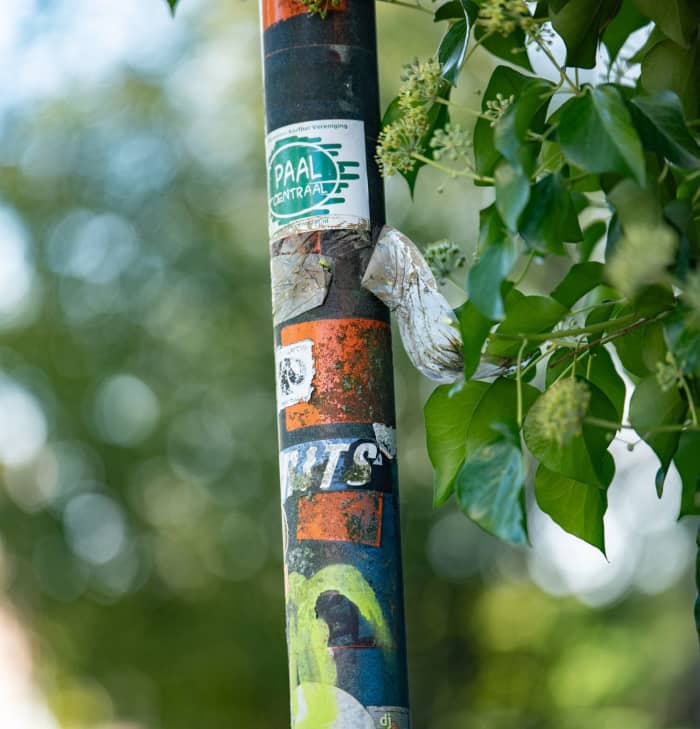Stickers Removal
Methods, Product types, and Challenge
-
Ko van den Boom
- Reading time: 24 minutes
- Methods, Products, Stickers, Vandalism

Sticker vandalism poses a significant challenge, especially for municipalities but also for cleaning services and property owners. While prevention strategies are essential, addressing the aftermath of sticker vandalism through effective removal methods is equally important and almost inevitable.
This blog post will explore various techniques for removing stickers, the products available for this purpose, the challenges faced during removal, and best practices to ensure successful outcomes.
Overview of Sticker Removal Techniques
Removing stickers can be a delicate process, as improper techniques can damage surfaces or leave behind residue which can become a bigger problem than the initial one. Here are some common methods used for sticker removal:
Contents
Ko van den Boom
Main Categories
Related articles
Main Categories
Physical Removal Methods
- Scraping away:
This method involves using a plastic scraper or a putty knife to gently lift the sticker off the surface. It can be effective on hard, non-porous surfaces but requires caution to avoid scratching, because there is high risk of damaging the surface. This method is the most obvious one, but is rarely employed by professionals which have to deal with larger surfaces and stickers that have been attached to the surface for a long time. And, of course, damaging the surface would undermine the whole cleaning effort. - Peeling off:
For stickers that are not firmly adhered, peeling them off by hand can be the simplest solution. However, this method, as simple as it sounds, will rarely work since stickers would have to be of a consistent material (ideally plasticized) and the glue on them would also have to be such that it doesn’t leave any residue. You sometimes see such stickers on consumer products when it is part of their function to be removed without a trace – this is almost never the case with the stickers that vandals use.
Chemical Solutions for removing stickers
- Glue Removers: Professional adhesive removers are designed to dissolve the sticky residue left by stickers. These products (especially of professional grade) are suitable for use on various surfaces and are fast acting. Products like Mavro Glue Removerare effective, but because they contain solvents, they should always be tested on a small area first to avoid damaging the surface. In combination with a mechanical method, like gentle scrubbing or a pressure washer (for stubborn sticker residue) a quality glue or sticker remover can be an almost unbeatable solution.
- Household Solutions: Common household items such as vinegar, rubbing alcohol, or citrus-based cleaners can also help dissolve adhesive. These alternatives are often less harsh than commercial products and may be more environmentally friendly, but their effectiveness is also verry limited and will only be useful for really basic sticker removal.
Mechanical Methods
- Pressure Washing:
For outdoor surfaces like sidewalks or walls, pressure washing can be effective for the removal of stickers without damaging the underlying material. It is seldom the case, however, that stickers need to be removed from porous surfaces, because they tend to adhere less on concrete, brick and similar materials. So, this simple solution is rarely of use. - Steam Cleaning: Using steam to soften the adhesive can make it easier to scrape off stickers. This method is particularly useful for smooth, slightly porous or nonporous surfaces where other methods might not work as effectively, because they are sensitive to solvents and other chemicals. Steam cleaning can be combined with chemicals, provided that the surface is studied beforehand and the right temperature of the hot water is established to avoid creating damage to the surface.
Challenges in Sticker Removal
While there are various methods available for sticker removal, several challenges can complicate the process. The main concern being keeping the surface undamaged, especially when dealing with stubborn remains of adhesives.
Surface damage risks in sticker removal efforts
One of the primary concerns during sticker removal is the potential for damaging the underlying surface. Different materials react differently to removal techniques:
- Painted surfaces: Scraping or using harsh chemicals may strip paint or finish, creating an even bigger issue than the initial one.
- Historic materials: Buildings made from stone or brick require specialized care and work by highly experienced professionals to avoid irreversible damage.
Sticker adhesive residue issues
Even after removing a sticker, stubborn adhesive residue often remains and can become the biggest issue of the task at hand. This sticky residue can attract dirt and grime, making surfaces appear unkempt and dirty. Effective removal of sticker residue is crucial:
- Additional Cleaning: After sticker removal, using a solvent or professional cleaning solution specifically designed for adhesive residues may be necessary. Again, it is of imperative importance (especially with substrates that are sensitive to solvents, acids and other chemicals) that the task is carried out by professionals who know the products well and understand how they interact with various materials.
- Surface Preparation: Ensuring that surfaces are clean and free from residue can help prevent future vandalism. Prompt removal also plays an important role, because a couple of stickers tend to give vandals incentive for applying more of them. Sometimes this results in big surfaces covered with stickers of different materials (and different adhesives) which makes removal even harder.
Environmental Concerns
The use of chemical solvents raises environmental concerns. Many commercial adhesive removers contain volatile organic compounds (VOCs) that can harm air quality. To mitigate these issues:
- Eco-Friendly Products: Opting for biodegradable or non-toxic adhesive removers can reduce environmental impact. Sticker removers tend to contain solvents, but a product like Mavro Glue removerdoes not contain harmful aromatic distillates found in other common glue removers and is hence safer to use that those that do.
- DIY Solutions: Utilizing homemade cleaning mixtures can minimize environmental harm, but these solutions have limited effectiveness and while they might be useful for home use, they will rarely produce the results needed by professional services, which usually need approaches that are consistent and not time consuming.
Home made solutions for sticker removal include:
- Vinegar and water Solution: Mixing equal parts vinegar and water creates acleaning solution that can dissolve mild adhesives.
- Baking Soda Paste: Combining baking soda with water creates a paste that can help lift sticky residues when applied and scrubbed gently. Again: not appropriate for more extensive or exhaustive sticker removal tasks and not to be used on sensitive surfaces
Specialized Tools for sticker removal
Certain tools can enhance the effectiveness of sticker removal efforts, especially when combined with appropriate chemical products:
- Plastic Scrapers: Essential for lifting stickers without scratching surfaces, provided that the substrate is of a harder material than the scraping tool.
- Heat Guns: Applying heat can soften adhesives, making it easier to peel off stickers without damaging the surface underneath, but here too, extreme caution must be exercised, since the intensity of the heat is hard to control and damage to the surface can occur very easily.
Surface treatments after stickers have been removed
Applying protective coatings after sticker removal can prevent or lessen adhesion of stickers applied in the future. Surfaces treated with anti-graffiti coatings are much easier to clean, and some coatings (like some types of nano coatings) even provide self-cleaning properties. Textured paints are also used sometimes, because rough textures can deter stickers from sticking effectively. This option is applicable only in situations where the look of the original substrate can be changed.
Conclusion
Removing stickers, especially those left by vandals, can be a surprisingly complex task. As we’ve seen, the variety of surfaces and adhesives demands a careful approach. While simple scraping or peeling might work for some stickers, most require specialized solvents, tools, and techniques carried out by professionals. It’s crucial to prioritize the preservation of the underlying surface, whether it’s a painted wall, bus or train interior, or a historic monument.
By understanding the challenges involved and choosing the right removal method and product, we can effectively combat sticker vandalism while protecting our public and private spaces. Remember, swift action and the use of appropriate products can make all the difference in restoring surfaces to their former appearance. Preventive methods are also an important part since they can reduce occurrences and/or make the removal of stubborn stickers easier. Read our article about sticker vandalism prevention.





